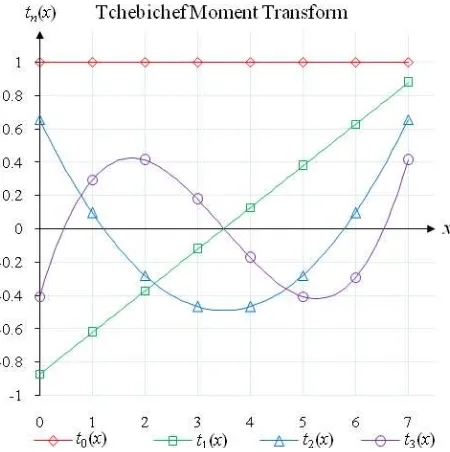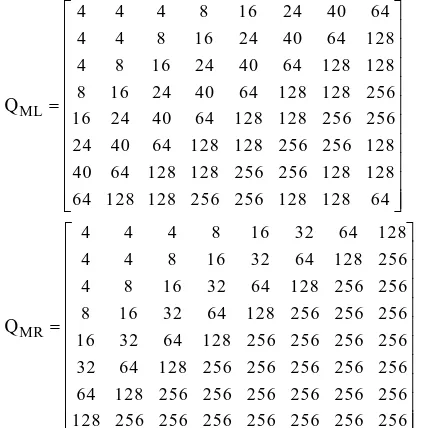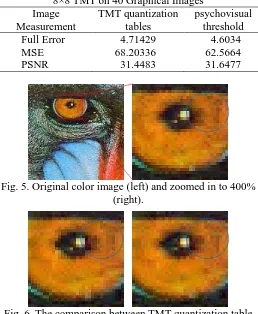Adv. Sci. Lett. 20, 070
–
074, 2014
RESEARCH ARTICLE
Copyright © 2014 American Scientific Publishers Advanced Science Letters All rights reserved Vol. 20, 070–074, 2014 Printed in the United States of America
An Optimal Tchebichef Moment Quantization using
Psychovisual Threshold for Image Compression
Ferda Ernawan1,2 , Nur Azman Abu1 and Nanna Suryana1
1
Faculty of Information and Communication Technology, Universiti Teknikal Malaysia Melaka, Melaka 76100, Malaysia
2
Faculty of Computer Science, Universitas Dian Nuswantoro, Semarang 50131, Indonesia
Colour image carries a certain amount of perceptual redundancy for the human eyes. The human eye is capable of perceiving various levels of colours. The sensitivity of human eye is useful for perceptual visual quality image in image compression. The visual sensitivity of the colour image in terms of image compression can be measured by a psychovisual threshold to generate the quantization tables. This paper will investigate a psychovisual threshold level for Tchebichef moment transform (TMT) from the contribution of its moments. In this paper presents a new technique to generate quantization table for TMT image compression based on psychovisual error threshold. The experimental results show that these new finer quantization tables based on psychovisual threshold for TMT provides better quality image and lower average bit length of Huffman code than previously proposed TMT quantization.
Keywords: TMT Quantization, Psychovisual Threshold, TMT Image Compression.
1. INTRODUCTION
The human eye has limited sensitivity to receive the visual information. The colour images possess a certain amount of perceptual redundancy1. The human visual system describes the way of human eye’s process toward image and how to relays it to the brain. By taking the advantages of some human eye’s properties, data redundancy can be removed without seriously degrading the image quality. In general, the human eye is more sensitive to luminance component of the image. The human eye has a non-linier response toward the drastic changes in intensity level and likely to be processed in different frequency channels2. The objective of this research is to develop quantitative measures that can automatically predict perceptual image quality3. In general, a psychovisual model has been designed based on our understanding of brain theory and neuroscience4, which is used to determine a threshold of human visual system’s sensitivity.
*
Email Address: [email protected]
This research proposes a model represented by a visual threshold based on Tchebichef moment by evaluating the image reconstruction. This experiment can be done by investigating the effect of incrementing TMT coefficient one by one. The effect of an increment in TMT coefficient is calculated and analyzed to get psychovisual threshold on the output image. This approach is used to generate quantization tables for TMT image compression.
RESEARCH ARTICLE
Adv. Sci. Lett. 20, 070
–
074, 2014
The organization of this paper is as follows. The next section provides a brief description of Tchebichef moment transform. Section 3 presents the experimental method in generating psychovisual threshold. The experimental results of TMT image compression based on new quantization table from psychovisual threshold are presented in Section 4. Lastly section 5 concludes this paper.
2. TCHEBICHEF MOMENT TRANSFORM
TMT is a two-dimensional transform based on discrete orthogonal Tchebichef polynomials3. For a given set {tn(x)} of input value (image intensity values) of size following recursive relation:
, Tchebichef moment transform is shown in Figure 1.
Fig. 1. The discrete orthogonal Tchebichef moments tn(x) for n
= 0, 1, 2 and 3. the inverse TMT is given as follows:
distribution.3. AN EXPERIMENTAL METHOD
In this quantitative experimental, 80 images (24-bit RGB with 512×512 pixels) are chosen to be tested and analyzed. The images are classified into 40 real images and 40 graphical images respectively. The RGB image is separated into a luminance (Y) and two chrominance (U and V). The images are divided into the 8×8 size blocks and each block of the image data is transformed by a two-dimensional TMT. Next, the resulting moment coefficients are incremented one by one. The effect of an increment on moment coefficients to the images is measured by the error reconstruction. Based on the discrete orthogonal moments above, a compact representation of the moment coefficient K(S×S) is given as above as follows:
) image to generate coefficient of discrete orthogonal TMT. The inverse moment relation used to reconstruct the image block from the above moments and is as follows:
Adv. Sci. Lett. 20, 070
–
074, 2014
RESEARCH ARTICLE
Fig. 2. Visual representation of the block matrices.
The use of moments for image analysis is to characterize an image segment and to extract properties that have analogies in statistics and mechanics. Each 8×8 block image is arranged in a linear order of the moment coefficient. The implementation of moment order by M(S×S) where S=8 for TMT is as provided below: order on moment coefficients are represented by m(1,0) and
m(0,1) coordinates. The second order of moment coefficients are located by (m(2,0), m(1,1) and m(0,2)) coordinates. Moment coefficients are incremented up to a maximum of quantization tables for each moment order. The TMT quantization tables13 are used as a reference for a maximum of an increment moment coefficients. The quantization tables for luminance QML and chrominance QMR on TMT have been originally proposed as follows:
calculated by image reconstruction error measurement. The average reconstruction error of an increment moment coefficient on luminance (Y) and Chrominance (U) for 40 natural images are shown in Figure 3 and Figure 4.
Fig. 3. Average reconstruction error of an increment on TMT coefficient for 40 natural color images.
Fig. 4. Average reconstruction error of an increment on TMT coefficient for 40 natural color images. The x-axis represents moment order and y-axis represents error reconstruction while the blue curve represents image reconstruction error based on a maximum quantization table value. The effect of an increment for each order shall produce a curve from zero to fourteen orders. In order to produce a psychovisual threshold, the new average designed reconstruction error is to get a smoothed curve which results in an ideal curve of average error scores. An ideal psychovisual threshold for luminance and chrominance is represented by a red curve. With reference to Figure 3 and Figure 4, the authors propose a psychovisual threshold for TMT basis function for luminance fML and chrominance fMR of quantization table Moment
RESEARCH ARTICLE
Adv. Sci. Lett. 20, 070
–
074, 2014
which are defined as follows:
4 functions can be used to generate new quantization tables for luminance and chrominance respectively as follows:
the newly proposed visual threshold. Each element of the moment coefficient is divided by the corresponding elements in an 8×8 quantization table and rounding the results. After the transformation and quantization of an 8×8 image sub-block is over, the DC coefficient is separated from the AC coefficients. Next, run length encoding is used to reduce the size of a repeating coefficient value in the sequence of a set of AC coefficients data.
Table.1. Average Bit Length of Huffman Code on TMT Image Compression for 40 Real Images Image
Measurement
TMT quantization tables
psychovisual threshold
DC Luminance Y 4.7660 4.7660
DC Chrominance U 2.0237 2.0237
AC Luminance Y 1.7679 1.7642
AC Chrominance U 1.2124 1.1665
Table.2. Average Bit Length of Huffman Code on Image Compression Using TMT for 40 Graphical Images
Image Measurement
TMT quantization tables
psychovisual threshold
DC Luminance Y 4.9000 4.9000
DC Chrominance U 3.2357 3.2357
AC Luminance Y 2.3588 2.3554
AC Chrominance U 2.0027 1.7544
The coefficient value can be represented compactly by simply indicating the coefficient value and the length of
its run wherever it appears. The output of run length coding represents a TMT coefficient as symbols and the length of occurrence of the symbols. The symbols and variable length of occurrence are used in Huffman coding to retrieve code words and their length of code words. Next, the average bit length score is calculated to find the average bit length of DC and AC coefficients. The average bit length newly of image compression based on default quantization and the proposed quantization based on psychovisual threshold for TMT are shown in Table 1 and Table 2.
The quality of image reconstruction based on new quantization table for TMT image compression is shown in Table 3 and Table 4. The image reconstruction error can be defined as follows:
refers to the value of three colors of RGB channels.Table.3. Average Image Reconstruction Error Score for 8×8 TMT on 40 Real Images
Image Measurement
TMT quantization tables
Table.4. Average Image Reconstruction Error Score for 8×8 TMT on 40 Graphical Images
Image Measurement
TMT quantization tables
Fig. 5. Original color image (left) and zoomed in to 400% (right).
Fig. 6. The comparison between TMT quantization table (left) and psychovisual threshold quantization table for
Adv. Sci. Lett. 20, 070
–
074, 2014
RESEARCH ARTICLE
In this experiment, the right eye of the baboon image is evaluated as presented on the left of Figure 5. In order to observe the visual quality of the image compression results, the image reconstruction is zoomed in to 400% as shown on the right of Figure 5. The experimental results of image compression using new quantization tables based on psychovisual threshold are shown on the right of Figure 6. The new quantization tables based on psychovisual threshold produces better quality image output than previously proposed TMT quantization tables13 for TMT image compression.
The observation as presented on the right of Figure 6 point out the fact that the new quantization tables based on psychovisual threshold produce almost the same as the original image on the right of Figure 5. In addition, the image output produces smooth texture as pointed inside of blue circle. The experimental results show that the TMT quantization tables based on psychovisual threshold produces lower average bit length of Huffman code by resulting in Table 1 and Table 2 than the earlier TMT image compression for both real and graphical images.
Image compression using psychovisual threshold produce better quality reconstruction image as shown in Table 3 and Table 4 than previous TMT image compression13. It has been observed from the experiment, the error reconstruction from TMT basis function is relatively equally distributed among the orders of image signals. The new technique quantization table generation based on psychovisual threshold produces high quality image reconstruction at lower average bit length of Huffman code on image compression.
5. CONCLUSIONS
The psychovisual threshold represents the human visual system’s sensitivity on the image intensity in term of image compression. The contribution of each frequency coefficient to the error reconstruction will be a primitive pyschovisual error. The psychovisual threshold appears in the value of the quantization table to assign the value of each frequency coefficient. This paper proposes a new technique to generate quantization tables based on psychovisual error threshold. This approach has been tested on TMT image compression. The new TMT quantization tables based on psychovisual threshold produces better quality image reconstruction at lower average bit length of Huffman code of the image compression than previously TMT quantization tables.
ACKNOWLEDGMENTS
The authors would like to express a very special thanks to Ministry of Higher Education (MOHE), Malaysia for providing financial support for this research project by Fundamental Research Grant Scheme (FRGS/2012/FTMK/SG05/03/1/F00141).
REFERENCES
[1] C.H. Chou, and K.C. Liu. A Perceptually Tuned Watermarking Scheme for Color Images. IEEE Transactions on Image
Processing, 19 (11), (2010) 2966-2982.
[2] H. Senane, A. Saadane and D. Barba. Design and Evaluation of an Entirely Psychovisual-Based Coding Scheme. Journal of Visual Communication and Image Representation, 12, (2001) 401-421.
[3] Z. Wang, A.C. Bovik, H.R. Sheikh and E.P. Simoncelli. Image Quality Assessment: From Error Visibility to Structural Similarity. IEEE Transaction on Image Processing, 13(4), (2004) 600-612.
[4] G. Zhai, X. Wu, X. Yang, W. Lin and W. Zhang. A Psychovisual Quality Metric in Free-Energy Principle. IEEE Transaction on Image Processing, 21(1), (2012) 041-052.
[5] R. Mukundan, S.H. Ong and P.A. Lee, “Image Analysis by
Tchebichef Moments,” IEEE transaction on Image Processing,
10 (9), (2001) 1357-1364.
[6] R. Mukundan and O. Hunt. A Comparison of Discrete Orthogonal Basis Functions for Image Compression. Proceeding Conference on Image and Vision Computing (IVCNZ 2004), (2004) 053-058.
[7] H. Shu, H. Zhang and L. Luo. Fast Computation of Tchebichef Moments for Binary and Grayscale Images. IEEE Transaction on Image Processing, 19 (2010) 3171-3180.
[8] N.A. Abu, N. Suryana and R. Mukundan. Perfect Image Reconstruction Using Discrete Orthogonal Moments. Proceeding of The 4th International Conference on Visualization, Imaging and Image Processing (VIIP2004), (2004) 903-907.
[9] F. Ernawan, N. A. Abu and H. Rahmalan. Tchebichef Moment Transform on Image Dithering for Mobile Applications. Proceeding of the SPIE, 8334 (2012) 83340D-5.
[10] H. Rahmalan, F. Ernawan and N.A. Abu. Tchebichef Moment Transform for Colour Image Dithering. 4th International Conference on Intelligent and Advanced Systems (ICIAS 2012), (2012) 866-871.
[11] F. Ernawan, E. Noersasongko and N.A. Abu. An Efficient 2×2 Tchebichef Moments for Mobile Image Compression. International Symposium on Intelligent Signal Processing and Communication System (ISPACS 2011), (2011) 001-005. [12] H. Rahmalan, N.A. Abu and W.S. Lang. Using Tchebichef
moment for fast and efficient image compression. Pattern Recognition and Image Analysis, 20 (2010) 505-512.


